National Provincial Championship (2006–present)
The National Provincial Championship (NPC), known for sponsorship reasons as the Bunnings NPC, is a professional rugby union competition for New Zealand provincial unions consisting of 14 teams, divided equally into two divisions based on the previous years finish. The NPC remains the second highest level of professional rugby union in New Zealand, after Super Rugby. The NPC's 12-week regular and finals season runs from August to October, with each team playing 10 games(5 home and 5 away), and having one week playing twice. Following the conclusion of the regular season, four teams from each division advance to a combined quarter finals, semi finals and a grand final.
| Current season, competition or edition: | |
 | |
| Formerly | Air New Zealand Cup (2006–09) ITM Cup (2010–15) Mitre 10 Cup (2016–20) |
|---|---|
| Sport | Rugby union |
| Founded | 2006 |
| Inaugural season | 2006 |
| CEO | Mark Robinson |
| No. of teams | 14 |
| Country | New Zealand |
| Headquarters | Wellington, New Zealand |
| Most recent champion(s) | Wellington (1st title) |
| Most titles | Canterbury (9 titles) |
| TV partner(s) | Sky Sport |
| Sponsor(s) | Bunnings Warehouse |
| Related competitions | Farah Palmer Cup Heartland Championship |
| Official website | https://www.provincial.rugby/ |
The current NPC competition was formed in 2006 as the Air New Zealand Cup, as the replacement of the original National Provincial Championship for the 2006 season. The New Zealand Rugby Union (NZRU) introduced the beginning of a professional era, announcing New Zealand's first ever professional rugby competition following the 2005 season, following the creation of the 14 new professional unions. The team with the most NPC championships is Auckland Rugby Union with fifteen (with two titles after the National Provincial Championship era); the team with the most modern day-NPC championships is Canterbury Rugby Union with nine. The current Champions are Wellington Rugby Union, who defeated Canterbury 26–18 in the 2022 Grand Final.
History
The 2006 reorganisation of New Zealand provincial rugby replaced the NPC's former three-division setup with two competitions. This differs from the original two-division setup used in the NPC from its creation in 1976 to 1984 in two key ways. The two current competitions are nationwide, while the original NPC Division Two was split on a North Island/South Island basis, and the NZRU ruled that there would initially be no promotion or relegation between the Air New Zealand Cup and Heartland Championship, a feature that had always been present in the former NPC. The number of teams was reduced to 26, as the Marlborough and Nelson Bays unions merged to form the new Tasman union.
The 2006 expansion of the Super 12 and Tri Nations Series had a major effect on the Air New Zealand Cup. This expansion created the Super 14, adding two extra fixtures to that competition, and also added two more Tri-Nations matches for the All Blacks in non-World Cup years. Because of these changes, it was intended for players in the All Blacks selection pool to make only limited appearances in the Air New Zealand Cup.
Original National Provincial Championship
Before 2006, a number of competitions involving regional and provincial rugby union teams had taken shape in New Zealand. The earliest of these was the National Provincial Championship, which was launched in 1976 and continued until 2006.
The competition was launched as the National Provincial Championship in 1976 with Bay of Plenty becoming the first champions. The competition, was the major domestic rugby competition in New Zealand. The National Provincial Championship saw many alterations to its format and brand. It was first contested in 1976, and although the basic format of Division One was much the same from then until the 2006 reorganisation, there were a number of changes to the lower divisions. The only change before 2006 was in 1998, when the number of teams in each division was changed to ten in Division One, nine in Division Two, and eight in Division Three. Having an even number of teams in Division One removed the necessity for byes. Starting that year, automatic promotion/relegation between the top two divisions was ended. In its place, the winner of Division Two played a promotion-relegation match against the bottom club in Division One to determine whether the clubs would switch places. Through 2002, this match was hosted by the bottom team in Division One, but the site was changed in 2003 to the home field of the Division Two champion. Auckland were the most successful team in the championship, having won 15 of the 30 series.
Air New Zealand Cup: 2006–09
The inaugural 2006 season was played by 14 teams over 13 weeks from 28 July until the grand final on 21 October. The inaugural format saw the season split into two rounds. In round one teams split into two pools and played everybody in their pool as well as a bye week. In round two the top three teams from each pool went into the top six, which faced every team they did not play in round one Every other team was split into either Repêchage A and Repêchage B, and the winners of each repêchage filled the two remaining spots for the quarter-finals with the top six. The quarter-finals were followed by semifinals and a grand final. The new competition saw the introduction of four teams elevated from Division two of the 2005 NPC; Counties Manukau, Hawke's Bay, Manawatu and Tasman (the amalgamation of the Nelson Bays and Marlborough unions). The competition was won by Waikato 37–31, after they beat Wellington in the Grand final in front of a capacity crowd of 25,000 fans at Waikato Stadium. The leading try-scorer was emerging star Richard Kahui from Waikato with eight tries, and the leading point-scorer was Jimmy Gopperth from Wellington with 121 points.
The 2007 season saw the NZRU dumping the pool system. The new format opened with a 10-week round-robin where each team missed out on playing three of the other teams. The finals format was not changed from 2006, with the quarter-finals, semi-finals and a grand final. The champion was Auckland, defeating Wellington in Wellington's second successive grand final. Auckland finished the season at the top of the points table with a record 48 competition points, winning all ten matches. Jimmy Gopperth again finished as leading points scorer with a record 155, while Brent Ward from Auckland was the top try scorer with eight tries.
The 2008 champion was Canterbury, handing Wellington its third consecutive grand final defeat in a low-scoring 7–6 game. Blair Stewart from Southland was the leading points-scorer, with 105 points, while Wellington's Hosea Gear was top try scorer with a record 14 tries. In August, the New Zealand Rugby Union announced that the Tasman and Northland teams would be relegated to lower competition after the completion of the season for failure to meet criteria which included financial stability, population, training, development, playing history, and administration. This decision was reversed in September, with Tasman and Northland remaining in the competition for two more years [1]
2009 saw more changes in the format. The season, which ran from 30 July to 25 October, was changed to a straight round-robin tournament where every team faced the others once over 13 weeks. Quarter-finals were dropped, with the top four regular season teams advancing directly to the semi-finals and the winners from each semi moving to the grand final. Regular season points were earned as per the Rugby Union Bonus Points System; 4 points for a win, 2 points for a draw and 1 point for scoring 4 tries or for losing by 7 points or less. Semi-finals were played between four teams, the teams are seeded first to fourth and the two highest seeded teams play at home against the two lowest seeded teams meaning first plays fourth and second plays third. The highest seed still remaining in the grand final played at home.
ITM Cup: 2010–15
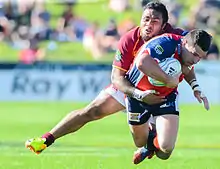
The 2010 ITM Cup was the 34th provincial rugby union competition, the fifth since the competition reconstruction in 2006 and the first under the new sponsor of ITM. It ran for 15 weeks, with 13 used for a round robin and 2 for the finals, from 29 July to 5 November.
Changes in 2011 saw the 14 teams split into two divisions, with the top seven playing in the Premiership, the rest in the Championship. The two divisions played each other, though their ten-game round-robin season saw each team playing only four games per year against teams in the 'other' division. Other key principles introduced were that the competitions must include Super Rugby players, have a stand-alone window, feature a full round-robin and play-offs, have promotion/relegation, guarantee four and five home games per team, be completed within a 10- to 12-week window and conclude by the end of October.
Mitre 10 Cup: 2016–20
In December 2015, Mitre 10 was announced as the new sponsor of all of New Zealand's major domestic rugby union competitions effective with the 2016 season. This included the top-level men's competition, formerly known as the ITM Cup; the second-level men's Heartland Championship, most recently sponsored by Pink Batts; the Women's Provincial Championship; and the Jock Hobbs Memorial National U19 tournament. This deal ran through to the 2020 season and was not renewed.[2]
Bunnings NPC: 2021–
In 2021 Bunnings Warehouse replaced Mitre 10 as the competition's main naming sponsor in a 3-year deal. The competition format of the Bunnings NPC was the same as that of the Mitre 10 Cup for the 2021 season, but from 2022 the competition has reverted to a single division format with the 14 teams arranged into two conferences. The top four teams in each conference qualify for the knockout stages.[3]
Current teams
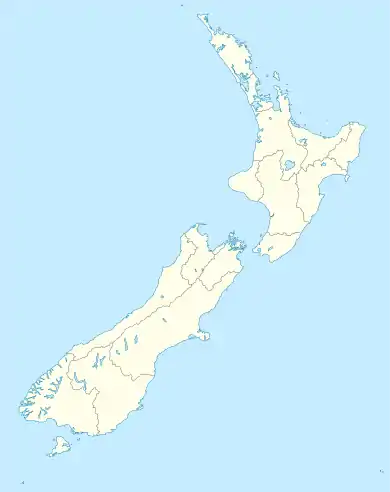
The NPC consists of 14 rugby teams divided into two divisions of 7 teams in each. Each NPC union is granted a professional side. Each team is under the governance of their union, they are the top male representative team that the union has to offer. Unions are based in regions across New Zealand, while the teams have not changed since the launch of the competition in 2006.
Throughout the championship, only two unions weren't among the other 12 that first competed in 1976. North Harbour established in 1985, being one of New Zealand's youngest provincial rugby unions. They joined the provincial rugby league by winning the third division in its first season, following promotion to the first division in 1987.[4] Tasman is New Zealand's youngest provincial union. Established in 2006, it brought together the Nelson Bays and Marlborough unions. Nelson Bays amalgamated with Marlborough following the restructuring of New Zealand's provincial championship in 2006.[5]
Whilst having new additions to the competition, another two unions were renamed throughout the NPC era. North Auckland Rugby Union established in 1920, changed its name to the Northland Rugby Football Union in 1994.[6] In 1955 South Auckland Counties was formed with full union status. The name was shortened to Counties the following year and in 1996 it became the Counties Manukau Rugby Football Union.[7]
In 2008, Northland and Tasman were chosen by the New Zealand Rugby Union as teams to drop out of the Cup as the union restructures its domestic competition. Tasman had expected to be cut, especially after Marlborough had said it wanted to split from Nelson Bays and go it alone in the Heartland Championship.[8]
| Team | Union | City | Established | Stadium(s) | Capacity | Head coach(es) | Colour(s) |
|---|---|---|---|---|---|---|---|
| Auckland | ARU | Auckland | 1883 | Eden Park | 50,000 | Alama Ieremia (fifth season) |
|
| Bay of Plenty | BOPRU | Tauranga | 1911 | Rotorua International Stadium | 26,000 | Mike Delany (first season) |
|
| Tauranga Domain | 5,000 | ||||||
| Canterbury | CRFU | Christchurch | 1879 | Orangetheory Stadium | 18,000 | Marty Bourke (first season) |
|
| Counties Manukau | CMRFU | Pukekohe | 1955 | Navigation Homes Stadium | 12,000 | Reon Graham (first season) |
|
| Hawke's Bay | HBRU | Napier | 1884 | McLean Park | 19,700 | Josh Syms (first season) |
|
| Manawatu | MRU | Palmerston North | 1886 | Central Energy Trust Arena | 15,000 | Peter Russell (fourth season) |
|
| North Harbour | NHRU | Auckland | 1985 | QBE Stadium | 25,000 | Ben Afeaki and Daniel Halangahu (second season) |
|
| Northland | NRU | Whangārei | 1920 | Semenoff Stadium | 30,000 | George Konia (third season) |
|
| Otago | ORFU | Dunedin | 1881 | Forsyth Barr Stadium | 30,748 | Tom Donnelly (third season) |
|
| Southland | RS | Invercargill | 1887 | Rugby Park Stadium | 20,000 | Dale MacLeod (third season) |
|
| Tasman | TRU | Nelson | 2006 | Lansdowne Park | 15,000 | Gray Cornelius and Dan Perrin (first season) |
|
| Trafalgar Park | 18,000 | ||||||
| Taranaki | TRFU | New Plymouth | 1885 | Pukekura Park | 4,000 | Neil Barnes (second season) |
|
| TET Stadium & Events Centre | 3,000 | ||||||
| Waikato | WRU | Hamilton | 1921 | FMG Stadium Waikato | 25,800 | Ross Filipo (second season) |
|
| Wellington | WRFU | Wellington | 1879 | Sky Stadium | 34,500 | Leo Crowley (third season) |
Format and sponsorship
Format
The NPC competition has changed a number of times. There have been up to three Divisions, with promotion/relegation between the two bottom divisions. Since 2006 there have been semi-finals and a final in each Division. Winners receive four competition points; if the game was a draw two points are awarded to each team. The Rugby union bonus points system is also used, where any team scoring four or more tries or losing by less than seven points receives an extra competition point. The top four teams at the end of the round-robin phase then played semifinals – the first placed team hosting the fourth team, and the second team hosting the third team. The two winners played the final at the home ground of the top surviving seed.
From 2013 onwards, the NPC has two Divisions, the Premiership and the Championship, each with seven teams. All teams play all other teams in their own Division and four teams from the other Division. This keeps up some of the traditional provincial rivalries.
Naming rights
From 2006 to 2010, airline and flag carrier of New Zealand Air New Zealand had naming rights and the competition was referred to as the Air New Zealand Cup.
In November 2015, provincial rugby sponsor ITM has been red-carded for the 2016 series. The building supplies company began its involvement in 2006, backing the national provincial series and the Heartland Championship. That sponsorship rose to competition-naming rights in 2010 when the company stepped up as major sponsor after the previous group withdrew. The ITM Cup, as it became known, started its six-season schedule. That deal ended for the 2016 season but the company wanted to renew its sponsorship. ITM put in a bid but had been told by the New Zealand Rugby Union that it had not been successful. ITM did not get a chance to match the investment from the new sponsor and had not been given any reason why it was overlooked for the twin provincial series for the next year.[9]
New Zealand-owned home improvement and garden retailer, Mitre 10 took over sponsorship in 2016 after they were announced the new title sponsor for the national domestic championship. With the inclusion of the Women's Provincial Championship and support of the Jock Hobbs Memorial National Under 19 tournament, Mitre 10 became the first sponsor of all major fifteens domestic rugby competitions in New Zealand.[10]
Ahead of the 2021 season, Bunnings Warehouse took over the sponsorship of the competition on a three-year deal, reverting the competition name back to the National Provincial Championship. The competition will be known as the Bunnings NPC. Bunnings will also sponsor the Farah Palmer Cup, Heartland Championship and the newly formed Super Rugby Aotearoa U20 competition.[11]
- Former Logos
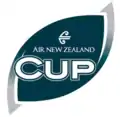 2006–2009
2006–2009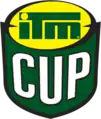 2010–2015
2010–2015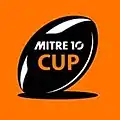 2016–2020
2016–2020
List of champions
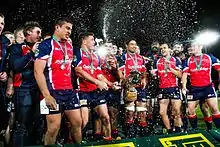
The NPC final is an annual New Zealand Rugby game that determines the champion of the Rugby Cup. The contest is held in a New Zealand city, chosen after the semi-finals, whom the highest seed semi-final winner is declared home advantage. Waikato defeated Wellington in the first revamped NPC Championship Game.
Before the 2006 revamp of the league, the National Provincial Championship was contested between three divisions, division one would be crowned and named the winner. Since 2011, the Premiership and Championship divisions were introduced. The winner of the Premiership Division are named the competition champion, whereas the Championship Division winner wins promotion to the Premiership to have a chance of holding the Rugby Cup and be crowned champions. So far five unions have gained promotion. Hawke's Bay twice, while Counties Manukau, Manawatu, North Harbour, Tasman, Waikato and Wellington all have been honoured once.
Canterbury have won the most finals with nine championships, while Auckland and Tasman have two and Taranaki and Waikato have one win. Canterbury has the most final appearances with ten, they also have the most consecutive appearances with six wins in a row from 2008 to 2013. Wellington are the only other team to have at least four consecutive appearances: 2006–09. Wellington have also lost a record of six finals, while Tasman and Auckland have lost three, Waikato have lost two and Canterbury losing once in 2018, the first time they've lost a final in their ten appearances. Taranaki are the only union to have a perfect record winning their only finals appearance in 2014.
| Final | Date | Winning team | Score | Losing team | Venue | City | Ref |
|---|---|---|---|---|---|---|---|
| 1. | 21 October 2006 | Waikato (1, 1–0) |
37–31 | Wellington (1, 0–1) |
Waikato Stadium | Hamilton | [12] |
| 2. | 24 October 2007 | Auckland (1, 1–0) |
23–14 | Wellington (2, 0–2) |
Eden Park | Auckland | [13] |
| 3. | 24 October 2008 | Canterbury (1, 1–0) |
7–6 | Wellington (3, 0–3) |
Westpac Stadium | Wellington | [14] |
| 4. | 7 November 2009 | Canterbury (2, 2–0) |
28–20 | Wellington (4, 0–4) |
AMI Stadium | Christchurch | [15] |
| 5. | 5 November 2010 | Canterbury (3, 3–0) |
33–13 | Waikato (2, 1–1) |
AMI Stadium | Christchurch | [16] |
| 6. | 3 November 2011 | Canterbury (4, 4–0) |
12–3 | Waikato (3, 1–2) |
Waikato Stadium | Hamilton | [17] |
| 7. | 27 October 2012 | Canterbury (5, 5–0) |
31–18 | Auckland (2, 1–1) |
AMI Stadium (Addington) | Christchurch | [18] |
| 8. | 26 October 2013 | Canterbury (6, 6–0) |
29–13 | Wellington (5, 0–5) |
Westpac Stadium | Wellington | [19] |
| 9. | 25 October 2014 | Taranaki (1, 1–0) |
36–32 | Tasman (1, 0–1) |
Yarrow Stadium | New Plymouth | [20] |
| 10. | 24 October 2015 | Canterbury (7, 7–0) |
25–23 | Auckland (3, 1–2) |
AMI Stadium (Addington) | Christchurch | [21] |
| 11. | 29 October 2016 | Canterbury (8, 8–0) |
43–27 | Tasman (2, 0–2) |
AMI Stadium (Addington) | Christchurch | [22] |
| 12. | 28 October 2017 | Canterbury (9, 9–0) |
35–13 | Tasman (3, 0–3) |
AMI Stadium (Addington) | Christchurch | [23] |
| 13. | 27 October 2018 | Auckland (4, 2–2) |
40–33 | Canterbury (10, 9–1) |
Eden Park | Auckland | [24] |
| 14. | 26 October 2019 | Tasman (4, 1–3) |
31–14 | Wellington (6, 0–6) |
Trafalgar Park | Nelson | [25] |
| 15. | 28 November 2020 | Tasman (5, 2–3) |
13–12 | Auckland (5, 2–3) |
Eden Park | Auckland | [26] |
| 16. | 20 November 2021 | Waikato (4, 2–2) |
23–20 | Tasman (6, 2–4) |
Waikato Stadium | Hamilton | [27] |
| 17. | 22 October 2022 | Wellington (7, 1–6) |
26–18 | Canterbury (11, 9–2) |
Orangetheory Stadium | Christchurch | [28] |
Finals appearances by union
In the sortable table below, teams are ordered first by number of appearances, then by number of wins, and finally by season of first appearance. In the "Season(s)" column, bold years indicate winning seasons, and italic years indicate games not yet completed.
| Appearances | Team | Wins | Losses | Winning percentage |
Season(s) |
|---|---|---|---|---|---|
| 11 | Canterbury | 9 | 2 | .818 | 2008, 2009, 2010, 2011, 2012, 2013, 2015, 2016, 2017, 2018, 2022 |
| 7 | Wellington | 1 | 6 | .143 | 2006, 2007, 2008, 2009, 2013, 2019, 2022 |
| 6 | Tasman | 2 | 4 | .333 | 2014, 2016, 2017, 2019, 2020, 2021 |
| 5 | Auckland | 2 | 3 | .400 | 2007, 2012, 2015, 2018, 2020 |
| 4 | Waikato | 2 | 2 | .500 | 2006, 2010, 2011, 2021 |
| 1 | Taranaki | 1 | 0 | 1.000 | 2014 |
Other provincial honours
The Air New Zealand Cup was unveiled by New Zealand Rugby Union Deputy Chief Executive Steve Tew and Air New Zealand Chief Executive Rob Fyfe at the official launch of the Air New Zealand Cup competition in Auckland. The trophy stands 45 cm tall and weighs 3.9 kilograms. It was hand forged from 2.7 kilograms of sterling silver by master silversmith Thorkild Hansen. The inside of the cup is gilded with gold. Waihi stone carver Jeff Beckwith handcrafted the polished stone base from black basalt quarried from the Bombay Hills.[29]
Ranfurly Shield
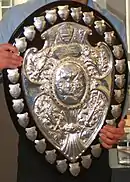
The Ranfurly Shield, colloquially known as the Log o' Wood, is perhaps the most prestigious trophy in New Zealand's domestic rugby union competition. First presented to Auckland in 1902, the Shield is based on a challenge system, rather than a league or knockout competition as with most football trophies. The holding union must defend the Shield in challenge matches, and a successful challenger becomes the new holder of the Shield. The Shield holder at the end of each season is required to accept at least seven challenges for the following year. All home games during league play, but not during knockout playoffs, in the NPC or Heartland Championship are automatic challenges. The remaining Shield defences must be made up of challenges from unions in the other domestic competition. For example, since North Harbour, an Air New Zealand Cup team, held the Shield at the end of the 2006 season despite losing their home quarter-final to Otago, they were forced to defend the Shield against Heartland Championship teams during the 2007 pre-season. Having successfully done so, all their home fixtures in the round-robin phase were Shield defences until they lost the shield to Waikato. The Shield is currently held by Wellington.
Inter-union trophies
| Date | Winning team | Score | Losing team | Trophy | Ref |
|---|---|---|---|---|---|
| 13 August 2021 | North Harbour | 14–6 (details) |
Counties Manukau | Lion Red Challenge Cup (Inaugurated unknown) |
[30] |
| 8 August 2021 | Auckland | 35–24 (details) |
Canterbury | Supporters' Club Cup (Inaugurated unknown) |
[31] |
| 7 August 2021 | Otago | 26–19 (details) |
Southland | Donald Stuart Memorial Shield (Inaugurated 1853) |
[32] |
| 16 October 2021 | Wellington | 36–16 (details) |
Manawatu | Coronation Cup (Inaugurated 1953) |
[33] |
| 19 September 2021 | Hawke's Bay | 36–33 (details) |
Bay of Plenty | MacRae-Shelford Bay Cup (Inaugurated 2017) |
[34] |
| 31 October 2020 | Auckland | 31–10 (details) |
Waikato | Stan Thomas Memorial Trophy (Inaugurated 1975) |
[35] |
| 22 October 2021 | Otago | 22–20 (details) |
Canterbury | Payne Trophy (Inaugurated 1922) |
[36] |
| 25 October 2020 | Wellington | 53–20 (details) |
Counties Manukau | Jonah Tali Lomu Memorial Trophy (Inaugurated 2016) |
[37] |
| 16 October 2021 | Taranaki | 33–26 (details) |
Waikato | Ryan Wheeler Memorial Trophy (Inaugurated 2001) |
[38] |
| 24 October 2020 | North Harbour | 23–22 (details) |
Auckland | Brian Purdy Battle of the Bridge Memorial Trophy (Inaugurated 2002) |
[39] |
| Newstalk ZB Trans Harbour Trophy (Inaugurated 1986) | |||||
| 24 October 2020 | Hawke's Bay | 47–12 (details) |
Manawatu | Kel Tremain Memorial Trophy (Inaugurated 1993) |
[40] |
| 8 October 2021 | Wellington | 35–30 (details) |
Canterbury | Harry Saundercock Memorial Trophy (Inaugurated 1965) |
[41] |
| 2 October 2020 | Auckland | 20–16 (details) |
Bay of Plenty | John Drake Boot Memorial Trophy (Inaugurated 2009) |
[42] |
| 20 September 2020 | Wellington | 39–21 (details) |
Auckland | Fred Lucas Memorial Trophy (Inaugurated unknown) |
[43] |
| 13 September 2020 | Taranaki | 36–29 (details) |
Bay of Plenty | Peter Burke Trophy (Inaugurated 2012) |
[44] |
| 12 September 2020 | Auckland | 38–6 (details) |
Otago | Lindsay Colling Memorial Trophy (Inaugurated 2005) |
[45] |
| 11 September 2020 | Canterbury | 43–29 (details) |
North Harbour | Kevin Gimblett Memorial Trophy (Inaugurated 2005) |
[46] |
| 24 September 2021 | Taranaki | 32–26 (details) |
Wellington | John F. Henning Trophy (Inaugurated unknown) |
[47] |
Player of the year
In 2017, New Zealand Rugby announced that the player of the year in the NPC will receive the Duane Monkley medal named in honour of the Waikato great, playing 135 matches for the province between 1987 and 1996. The Player of the Year awards will be determined by a season-points system, with match officials picking their players of the match awarding three points, two points and one point for the game's top three performers.
Prior to 2017 it was simply awarded to the outstanding Player of the Year chosen by a panel of committee members, former players and media representatives.[48]
| Year | Winner | Position | Team | Ref |
|---|---|---|---|---|
| 2006 | Richard Kahui | Centre | Waikato | [49] |
| 2007 | Isa Nacewa | Centre | Auckland | [50] |
| 2008 | Jamie Mackintosh | Prop | Southland | [51] |
| 2009 | Mike Delany | First five-eighth | Bay of Plenty | [52] |
| 2010 | Robbie Fruean | Centre | Canterbury | [53] |
| 2011 | Aaron Cruden | First five-eighth | Manawatu | [54] |
| 2012 | Robbie Fruean | Centre | Canterbury | [55] |
| 2013 | Andrew Ellis | Half-back | Canterbury | [56] |
| 2014 | Seta Tamanivalu | Centre | Taranaki | [57] |
| 2015 | George Moala | Centre | Auckland | [58] |
| 2016 | Jordie Barrett | Fullback | Canterbury | [59] |
| 2017 | Jack Goodhue | Centre | Northland | [60] |
| 2018 | Luke Romano | Lock | Canterbury | [61] |
| 2019 | Chase Tiatia | Fullback | Bay of Plenty | [62] |
| 2020 | Folau Fakatava | Half-back | Hawke's Bay | [63] |
| 2021 | Stephen Perofeta | First five-eighth | Taranaki | [64] |
Salary cap
In 2015 the minimum value of any contract is $18,000, paid regardless of whether the individual plays a single game or not, with that payment counting towards the salary cap. No union can spend more than $1.025 million on salaries. The maximum value of any individual contract cannot exceed $55,000 a season. Provincial unions are reimbursed by the NZRU $50,000 for every contracted All Black on their books who goes to the 2015 World Cup. If that All Black becomes available for any reason, the union has to pay back a pro-rata fee to the NZRU to gain access to the player. All Blacks unavailable due to test commitments do not count towards the salary cap.[65]
Club competitions
Each respective province competing in the NPC has a number of their own club leagues, which feed into NPC teams. In New Zealand, the NPC is the most prominent domestic competition below Super Rugby, in which all the respective Unions are also aligned with Super Rugby sides.
See also
- Heartland Championship
- National Provincial Championship (1976–2005)
- Ranfurly Shield
- List of New Zealand rugby union teams
- Lion Foundation Cup, women's equivalent competition
- Major League Rugby
References
- "Northland and Tasman saved from axe". Stuff.co.nz. 26 September 2008. Retrieved 6 October 2011.
- "Mitre 10 unveiled as new sponsor of national provincial rugby competitions" (Press release). New Zealand Rugby. 13 December 2015. Archived from the original on 16 December 2015. Retrieved 18 December 2015.
- "NEW COMPETITION FORMAT FOR THE BUNNINGS WAREHOUSE NPC". provincial.rugby. 3 February 2022. Retrieved 29 June 2022.
- "North Harbour rugby". New Zealand History. 22 February 2017. Retrieved 22 February 2017.
- "Tasman rugby". New Zealand History. 22 February 2017. Retrieved 22 February 2017.
- "Northland rugby". New Zealand History. 22 February 2017. Retrieved 22 February 2017.
- "Counties Manukau rugby". New Zealand History. 22 February 2017. Retrieved 22 February 2017.
- "Rugby: Axed provinces eye legal fight". Otago Daily News. 12 August 2008. Retrieved 22 February 2017.
- "No more ITM Cup as sponsor red-carded" (Press release). New Zealand Herald. 26 November 2015. Retrieved 16 January 2016.
- "Mitre 10 Named Competition Sponsor" (Press release). Manawatu Turbos. 14 December 2015. Retrieved 16 January 2016.
- "New Zealand's provincial championship reverts to NPC moniker as new sponsor unveiled and competition formats confirmed". Rugby Pass. 1 April 2021. Retrieved 21 April 2021.
- "Waikato claim Air NZ Cup". ESPN. 22 October 2006. Retrieved 12 August 2021.
- "Glory for all-conquering Auckland". ESPN. 20 October 2007. Retrieved 12 August 2021.
- "Canterbury claim Cup glory". ESPN. 25 October 2008. Retrieved 12 August 2021.
- "Canterbury edge out Wellington for Cup glory". ESPN. 7 November 2009. Retrieved 12 August 2021.
- "Canterbury celebrate stunning hat-trick". ESPN. 5 November 2010. Retrieved 12 August 2021.
- "Canterbury clinch ITM Cup crown". ESPN. 3 September 2011. Retrieved 12 August 2021.
- "Canterbury down Auckland for provincial glory". ESPN. 27 October 2012. Retrieved 12 August 2021.
- "Canterbury claim sixth successive title". ESPN. 25 October 2013. Retrieved 12 August 2021.
- "Taranaki crowned champions of New Zealand". ESPN. 24 October 2014. Retrieved 12 August 2021.
- "Canterbury hold nerve to pip Auckland in dramatic NPC premiership final". Stuff. 24 October 2015. Retrieved 12 August 2021.
- "Canterbury win eighth NPC title since 2008 after beating Tasman in Christchurch". Stuff. 29 October 2016. Retrieved 12 August 2021.
- "Canterbury too strong for brave Tasman side in Mitre 10 Cup showdown". Stuff. 28 October 2017. Retrieved 12 August 2021.
- "Auckland champions after dramatic grand final comeback victory over Canterbury". Stuff. 27 October 2018. Retrieved 12 August 2021.
- "Mitre 10 Cup: Tasman Mako overpower Wellington to bag maiden national title". Stuff. 26 October 2019. Retrieved 12 August 2021.
- "Tasman Mako win tense Mitre 10 Cup final against Auckland". Stuff. 28 November 2020. Retrieved 12 August 2021.
- "Waikato claim NPC Premiership title with win over Tasman in breathtaking final". Stuff. 20 November 2021. Retrieved 20 November 2021.
- "TJ Perenara and Wellington produce magic to beat Canterbury in NPC final". Stuff. 22 October 2022. Retrieved 22 October 2022.
- "Stunning New Air New Zealand Cup Unveiled". 14 July 2006. Retrieved 4 May 2013.
- "NPC: North Harbour defeat Counties Manukau in one-try battle". Stuff. 13 August 2021. Retrieved 14 August 2021.
- "AJ Lam puts Canterbury to the slaughter, with three tries in win for Auckland". Stuff. 8 August 2021. Retrieved 12 August 2021.
- "NPC: Otago beat Southland in dramatic finish but lose star player Jona Nareki". Stuff. 7 August 2021. Retrieved 12 August 2021.
- "Mitre 10 Cup: Wellington beat Manawatū to avoid relegation and retain semifinal hope". Stuff. 14 November 2020. Retrieved 12 August 2021.
- "Mitre 10 Cup: Kaleb Trask brilliance inspires Bay of Plenty to victory over Hawke's Bay". Stuff. 2 November 2020. Retrieved 12 August 2021.
- "Mitre 10 Cup: Salesi Rayasi hat-trick fires Auckland to top spot in Premiership". Stuff. 31 October 2020. Retrieved 12 August 2021.
- "Mitre 10 Cup: Otago snap 15-year drought to put Canterbury's season on life-support". Stuff. 30 October 2020. Retrieved 12 August 2021.
- "Mitre 10 Cup: Wellington storm past Counties-Manukau to retain beloved trophy". Stuff. 25 October 2020. Retrieved 12 August 2021.
- "Mitre 10 Cup: Waikato overcome Taranaki and go top of Premiership standings". Stuff. 25 October 2020. Retrieved 12 August 2021.
- "Mitre 10 Cup: Akira Ioane excels, but North Harbour hold out to beat Auckland". Stuff. 24 October 2020. Retrieved 12 August 2021.
- "Hawke's Bay blitz fading Manawatū team to retain Ranfurly Shield". Stuff. 24 October 2020. Retrieved 12 August 2021.
- "Mitre 10 Cup: Canterbury pip Wellington in first golden point match". Stuff. 3 October 2020. Retrieved 12 August 2021.
- "Mitre 10 Cup: Salesi Rayasi double lifts Auckland to nail-biting win over Bay of Plenty". Stuff. 2 October 2020. Retrieved 12 August 2021.
- "Mitre 10 Cup: Wounded Wellington bounce back with statement victory over Auckland". Stuff. 20 September 2020. Retrieved 12 August 2021.
- "Barrett brothers triumph as All Blacks captain Sam Cane's losing run drags on". Stuff. 13 September 2020. Retrieved 12 August 2021.
- "Mitre 10 Cup: Auckland flex muscles against Otago, Sio Tomkinson sees red again". Stuff. 12 September 2020. Retrieved 12 August 2021.
- "Mitre 10 Cup: All Black Codie Taylor's brace powers Canterbury past North Harbour". Stuff. 11 September 2020. Retrieved 12 August 2021.
- "Dane Coles has immediate impact for Wellington as Taranaki relegated". Stuff. 12 October 2018. Retrieved 12 August 2021.
- "National provincial rugby's best men's player to get Duane Monkley Medal". Stuff. 16 August 2017. Retrieved 16 August 2017.
- "Richie McCaw heads for third major rugby award". New Zealand Herald. 4 December 2006. Retrieved 12 August 2021.
- "Rugby: Aucklanders dominate award nominations". New Zealand Herald. 14 November 2007. Retrieved 12 August 2021.
- "Rugby: 'Dingo' Deans in line for NZ award". New Zealand Herald. 6 November 2008. Retrieved 12 August 2021.
- "Rugby: Chiefs recognised in nominations". New Zealand Herald. 20 November 2009. Retrieved 12 August 2021.
- "Read among those nominated for rugby awards". Newshub. 20 November 2010. Retrieved 12 August 2021.
- "All Blacks dominate awards nominations". New Zealand Herald. 10 November 2011. Retrieved 12 August 2021.
- "All Blacks, Chiefs dominate nominations for Steinlager Rugby Awards". Newshub. 12 November 2012. Retrieved 12 August 2021.
- "NZ rugby awards nominations announced". Newshub. 14 November 2013. Retrieved 12 August 2021.
- "Rugby: All Blacks sweep nominations". New Zealand Herald. 26 November 2014. Retrieved 12 August 2021.
- "Four Manawatu finalists in the New Zealand Rugby Awards". Stuff. 16 November 2015. Retrieved 12 August 2021.
- "All Black Beauden Barrett hot award favourite at NZ rugby awards". New Zealand Herald. 15 December 2016. Retrieved 12 August 2021.
- "Finalists named for NZ Rugby Awards". Radio New Zealand. 3 December 2017. Retrieved 12 August 2021.
- "New Zealand Rugby Awards nominees announced for 2018". Newshub. 5 December 2018. Retrieved 12 August 2021.
- "2019 ASB Rugby Awards: All Blacks, Black Ferns, sevens – all nominations revealed". New Zealand Herald. 3 December 2019. Retrieved 12 August 2021.
- "Rugby: Stacey Fluhler and Aaron Smith lead New Zealand Rugby awards nominations". New Zealand Herald. 14 December 2020. Retrieved 12 August 2021.
- "Sarah Hirini collects three major prizes at ASB Rugby Awards". allblacks.com. 15 December 2021. Retrieved 28 July 2022.
- "Rugby: ITM Cup snub for Pacific players" (Press release). New Zealand Herald. 3 March 2015. Retrieved 20 January 2015.
External links
- Official website of the ITM Cup
- Air New Zealand Cup News from Prime Rugby
- ANZ Rugby News
- NPC Rugby News
- Summary of the 2006 Air New Zealand Cup format at allblacks.com (PDF)